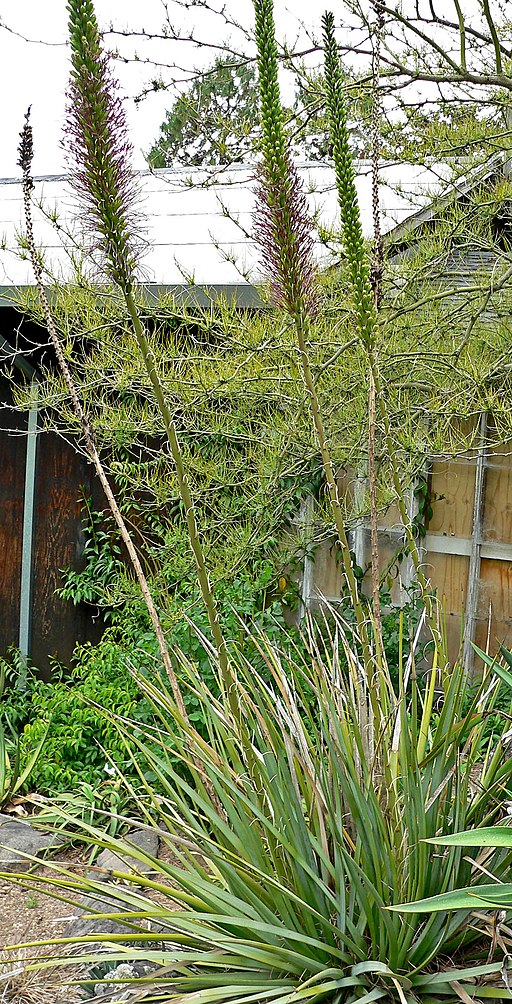Classification System: APG IV
Superregnum: Eukaryota
Regnum: Plantae
Cladus: Angiosperms
Cladus: Monocots
Ordo: Asparagales
Familia: Asparagaceae
Subfamilia: Agavoideae
Genus: Agave
Subgenus: A. subg. Littaea
Sectio: A. sect. Striatae
Species: Agave striata
Subspecies: A. s. subsp. falcata – A. s. subsp. striata
Name
Agave striata Zucc., 1833
Distribution
Native distribution areas:
Continental: Northern America
Regional: Mexico
NE. Mexico
References: Brummitt, R.K. 2001. TDWG – World Geographical Scheme for Recording Plant Distributions, 2nd Edition
References
Zuccarini, J.G., 1833. Nova Acta Physico-Medica Academiae Caesareae Leopoldino-Carolinae Naturae Curiosorum Exhibentia Ephemerides sive Observationes Historias et Experimenta ... 16(2):678.
USDA, ARS, National Genetic Resources Program. Germplasm Resources Information Network - (GRIN) [Online Database]. [1]
Links
Govaerts, R. et al. 2019. Agave striata in World Checklist of Selected Plant Families. The Board of Trustees of the Royal Botanic Gardens, Kew. Published online. Accessed: 2019 Jan. 05. Reference page.
International Plant Names Index. 2019. Agave striata. Published online. Accessed: Jan. 05 2019.
The Plant List 2013. Agave striata in The Plant List Version 1.1. Published online. Accessed: 2019 Jan. 05.
Tropicos.org 2019. Agave striata. Missouri Botanical Garden. Published online. Accessed: 05 Jan. 2019.
Vernacular names
Agave striata is a plant species native to Northeastern Mexico.[3][4] Because the species is widespread and does not appear to be under any significant threats, it is not considered by the IUCN to be threatened.[1]
Description
A. striata forms rosettes of hundreds of thin, narrow leaves, 60 cm (2 feet) long and 1.0 cm (0.4 inches) wide. The leaves stick straight out or arch gently upward toward the center of the plant, each ending in a very sharp, brown and black spine. The flower spike is up to 3 m (10 feet) tall and bears whitish yellow flowers 3.0-4.0 cm (1.2-1.6) inches in diameter. In the wild, numerous suckers result in thick clusters of plants growing to form impenetrable thickets.[5][6][7]
References
Hernández Sandoval, L.; González-Elizondo, M.; Zamudio, S.; Sánchez, E.; Hernández-Martínez, M.; Matías-Palafox, M. (2019). "Agave striata". IUCN Red List of Threatened Species. 2019: e.T115691222A116354513. doi:10.2305/IUCN.UK.2019-3.RLTS.T115691222A116354513.en. Retrieved 19 November 2021.
"The Plant List: A Working List of All Plant Species".
CONABIO. 2009. Catálogo taxonómico de especies de México. 1. In Capital Nat. México. CONABIO, Mexico City.
Zuccarini, Joseph Gerhard. Novorum Actorum Academia Caesareae Leopoldinae-Carolinae Germanicae Naturae Curiosorum 16(2): 678. 1833.
Zdeněk Ježek & Libor Kunte. 2005. Complete Encyclopedia of Succulents. Rebo.
Bailey, L.H. & E.Z. Bailey. 1976. Hortus Third i–xiv, 1–1290. MacMillan, New York.
Gentry, H. S. 1982. Agaves of Continental North America i–xiv, 1–670. The University of Arizona Press, Tucson.
Retrieved from "http://en.wikipedia.org/"
All text is available under the terms of the GNU Free Documentation License


